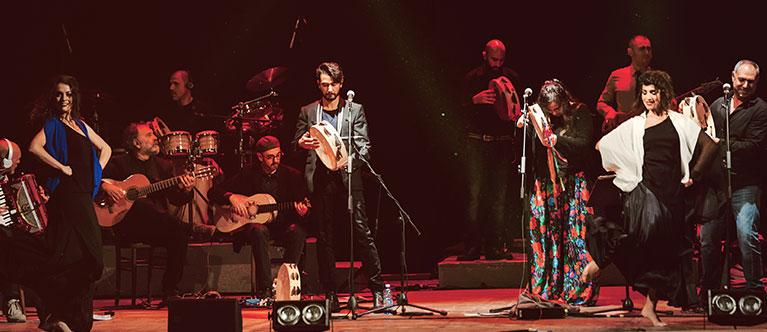Pizzica is part of the great tarantella family; is a traditional folk dance originally found in southern Puglia (Salento) and eastern Basilicata.
The traditional pizzica pizzica is danced in pairs. The couple does not necessarily have to be formed by individuals of the opposite sex: quite commonly two women dance together, while it is increasingly rare to observe two men dancing together, although in the past the dance between two men was much more frequent than that between a man and a woman.
The tarantata pizzica takes its origins from the ancient therapeutic dance of Tarantism, made up of very fast jumping steps and non-stop spins that follow the pressing rhythm of the tambourines, in an exhausting and entrancing dance at the same time that leads the dancers to dance without truce until the end of their strength for a liberating end. It is ascertained that the dance of the taranta has origins that go back to the ancient Greeks linking it to the Dionysian rites (Dionysian mysteries).
Another form of pizzica is fencing, often improperly called "sword dance" which is part of the family of armed dances, that is, traditional dances in which two challengers simulate a fight with weapons.
In the case of fencing, the weapon used is the knife, which is represented by the index and middle finger of the hand. In Salento fencing is accompanied by pizzica pizzica, played with a rhythmic rhythm and with the use of a more limited number of instruments (tambourine, organetto mouth organ). In the Lower Salento the place where it is easier to observe this tradition is the Feast of San Rocco in Torrepaduli, a fraction of Ruffano (LE) which takes place during the days around mid-August. The feast of San Rocco traditionally coincided with one of the most important peasant fairs in the province, and was a time of pilgrimage by devotees of San Rocco. Both the pilgrims and the numerous merchants spent the night waiting for the opening of the church and the beginning of the fair in front of the Sanctuary, deceiving the time by playing, singing and, in some cases, dancing fencing.
This dance has its roots in the rustic duels that in ancient times was considered the only worthy method to regularize feuds between rival families or to defend honor and betrayed pride.
Subsequently this ritual was transformed into bloody dances by the gypsies who once ran the cattle markets in Salento, who associated the fighting movements to the rhythm of pizziche, giving life to a primordial fencing dance.
The ancient duels remain represented by the multiple steps that simulate the attack, the lunges, the feints, the forbidden blows and the defense, accompanied by articulated movements of arms and hands and by a threatening gaze towards the opponent.
Dancers must strictly adhere to very specific rules typical of a real duel, such as never turning their backs on each other, always being alert and maintaining a certain physical distance.
Of course the winner is always the oldest dancer and the "fencing dance" ends with a bow between the two "adversaries".
But it didn't end here ... At this point a challenger comes forward to take the place of the loser and the dance continues ...

A further variant of pizzica is the pizzica de core, in which the eroticism and passion that accompanies the complex and provocative courtship ritual between a man and a woman is represented in a very engaging way.
In this case the dancers are of the opposite sex and dance without ever touching, in a continuous approaching and moving away of the bodies where the only contact is that of the gaze. Provocative and inviting her, eager to conquer his.
There are no precise steps in this dance, it is a continuous chasing of the couple, in which it is now he who turns closer and closer to the woman, who makes small jumps on the spot, or she who spins alone in the air away from him.
It is the woman who leads the dance and invites the partner to come closer, but the moment the approach becomes urgent, here it is that it withdraws away. If the suitor is no longer welcome, the dancer will invite someone else to dance by waving a red handkerchief in the air, a symbol of passion, which will give only to the chosen final.
An important strength remains the game of provocative glances that visually narrate courtship.
The interpretative freedom of the dance makes it one of the most beautiful dances of the Salento cultural tradition, as it allows continuous reinterpretations that depend on the personal involvement of each one. This dance is therefore devoid of pre-packaged schemes and this makes it accessible to everyone.
Through dance and music, that is two of the most ancient arts in the world, Salento manages to tell its story and make itself understood even by those who are far from its borders. The pizzica and the tarantate represent an important piece of the history of this territory and in particular of Galatina, of its identity and its culture. A precious mix and a source of pride for everyone in the era of globalization, as a sign of the continuation of a strong and beautiful local identity. Salento is known all over the world, not only for the beauty of its places and the richness of its culture but above all for its compelling strength and the fascination of its popular traditions and Galatina is an example.


